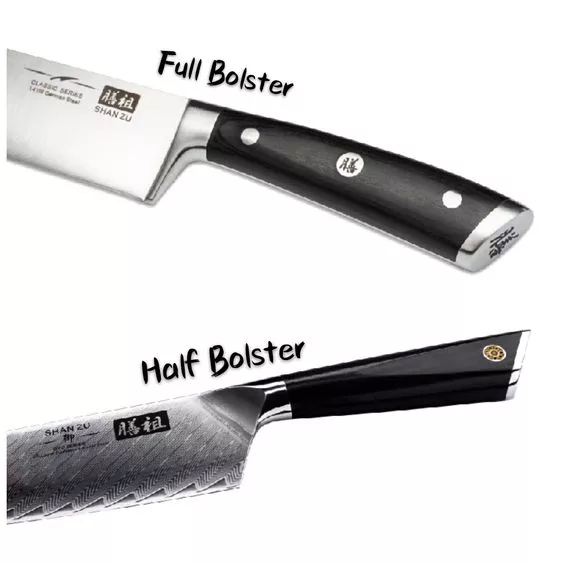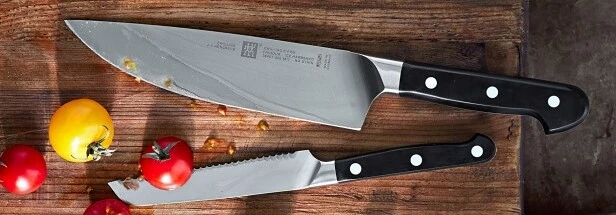Table of Contents
A knife bolster is a simple but essential part of your knife anatomy. Having the right bolster enhances the function ability of your knife. But the wrong bolster can render the best knife unusable. In this guide, we will examine the importance of a knife bolster. We will also discuss the various bolsters available in the market today.
What is a Knife Bolster?
A knife bolster is a buffer between the knife’s handle and blade. A knife bolster is a thick band of material on a blade that runs perpendicular across the blade from the heel to the spine between the handle and the blade.
Bolsters are a common feature of western knives, especially German knives and are sometimes referred to as the knife shoulder. In most cases, western full tang professional knives come with bolsters. For forged knives, bolsters are a part of the blade.
In this case, the thickness of the bolster indicates the original thickness of the knife. But a bolster can also be an extra feature of a knife. It can be laser cut or stamped from a metal sheet and fixed to the blade.
What is the Purpose of a Bolster?
- Increases the Knife’s Workability
A knife bolster adds extra weight to the knife, providing better balance. In turn, the balance contributes to smoother control of the knife. Thus, you get a firmer grip, making your tasks easier.
A knife bolster provides a smooth shift from the blade to the handle. It also offers more strength to the knife. In most knives, the blade is lighter than the handle.
- Protects You
A knife bolster prevents you from cutting yourself when using the knife. It also protects you if the blade snaps when the knife is in use.
- Increases the Durability of the Knife
A knife’s weakest point is the handle and blade joint. It is at this point that the knife is most likely to break. A bolster provides extra support to this sensitive area preventing any possible snaps. Also, the extra balance that the bolster provides further enhances the knife’s durability.
- Adds a Touch of Style and Comfort
A knife bolster adds a stylish look to the knife, especially brass bolsters that can be polished to achieve an aesthetically pleasing mirror finish. Moreover, the bolster provides a comfortable resting place for your fingers.
Should Knives Have a Bolster?
It is not a must for all knives to have a bolster. Some knives do not have this feature for various reasons. Different blades have various handle designs. Some handles offer a complete knife balance and do not need extra support.
Also, some handles have an extra coating that prevents slipping. In such cases, the extra buffer between the blade and the handle is unnecessary. Moreover, a full tang knife may not need a buffer. The tang goes all the way through the handle. Even without a bolster, the blade is stable enough.
A knife bolster may also be a hindrance when sharpening the knife making the sharpening process significantly harder and thus may be avoided.
Another reason your knife may not need the bolster is its nature. Pocket knives and pen knives do not handle complex tasks. Thus, it may be unnecessary for them to have a bolster.
Types of Bolsters
A knife can either have a full bolster or a Half bolster.

Full Bolster
A full bolster extends from the top to the bottom of the blade. In some cases, a full bolster has a shield that prevents blade contact when using the knife.
A full bolster is ideal for butcher knives as it offers finger protection when using force in your tasks. Also, a full bolster is perfect for fileting and boning knives. When using the blade in wet conditions, the fingers may slip. In such cases, a full bolster prevents the fingers from coming into contact with the blade.

Pros of a Full Bolster
- Offers complete finger protection
- Increases the knife balance
Cons of a Full Bolster
- Sharpening a full bolster knife can be difficult.
Half Bolster
A Half bolster covers the top part of the blade but only goes about halfway to the bottom. This knife performs well on regular kitchen tasks such as chopping and slicing.
Also, a Half knife bolster is ideal if you work in a busy environment. A full bolster may come in the way of sharpening the knife, making it a challenging task.

Pros of a Half Bolster Knife
- It is easy to use for everyday kitchen tasks
- Easier to sharpen the blade
Cons of a Half Bolster Knife
- Offers partial protection of the fingers
- You need to be careful in the areas between the tang and the bolster as they may keep dirt.
Bolster Materials
The three common materials used in making knife bolsters are metal, plastic, and wood.
Metal
Metal is the most popular material in making bolsters. The bolsters are available in brass, aluminium, and steel varieties. Most bladesmiths like metal bolster as they are sturdy, bring about balance, and are easy to polish.
The metal bolsters are shaped from the same piece of material as the forged knives. Other metal bolsters are laser-cut and stamped into place. One of the most significant advantages of metal bolsters is that they are durable. Forged metal bolsters provide extra balance as they are part of the blade.
Brass Bolsters are commonly available in most forged knives. Brass Bolsters are aesthetically pleasing and easy to forge into the blade shape. Contrary to the Misconception brought about by Prop 65 warning.
Brass bolsters are not dangerous. Brass bolsters are safe as there is typically not enough lead in the knife to affect you in normal use. Brass Bolsters won’t leech out onto your hand and won’t contaminate food.
Plastic
Some manufacturers use plastic to create a buffer between the knife and the blade. Plastic bolsters are light and ideal for blades such as pocket knives. But the material is not suitable for large knives as they may lack balance.
Wood
Wood bolsters are the perfect choice for outdoors and hunting knives. Apart from creating balance, wood also offers a firm grip because of its texture. If you opt for wood bolsters, clean the blade between the tang and the bolster well, as it may store some dirt.
Knife Bolster or Not?
Whether to use a knife that has a bolster depends on your personal preferences. Some chefs prefer one over the other. Others may opt to use the two depending on the task that is at hand.
If you are shopping for a knife, you may want to consider all the aspects of the knife. It is advisable to look at the length, balance, thickness of the blade, and tang type.
If you opt for a knife with a full bolster, you may need to consider your sharpening options. Another important consideration is the purpose of the blade. As we have seen, a full bolster may come in the way of performing the regular kitchen tasks. But this bolster is ideal for the more challenging tasks.
What Makes a Good Bolster?
If you opt for a knife with a bolster, you must ensure it is good. Whether you choose a full bolster or a Half bolster, ensure that there is no space between the handle and the blade. A sign of a quality forged blade is a bolster that is an integrated part of the blade rather than a separate “collar”.
Also, you may want to look at the different material types. Choose the one that feels most comfortable in your hands.
Do Japanese Knives Have a Bolster?
Most Japanese Kitchen knives do not have a bolster. Also, the tangs of the blades depend on the manufacturer. But most knife makers prefer full tangs. Most Japanese prefer using wood on the handles, thus increasing the grip on the knife.
Thus, even without a bolster, the Japanese knives are well balanced. Japanese blades are thinner and lighter than most German blades. You do not need to apply much pressure when using the knives.
Bolsters are more common in the western, in most cases German knives. The extra weight from the bolsters gives the knives a better feel for heavier tasks.
Knife Bolster vs Guard
A knife bolster’s purpose is to provide balance to the blade especially on full tang blades for enhanced handling of the knife during cutting, while a knife Guard’s purpose is to guard your hand against slipping up the handle when using the knife.
A knife bolster is also used to strengthen (bolster) the weak point of the knife between the handle and the blade. Bolsters in this case may be present in different sections of the handle and not just between the handle and the blade.
Most knife guards will often have Quillions that extend out considerably to protect hands from slippage onto the blade. Common knives with quillions are outdoor knives and fighting knives.
Some Bolsters may be shaped like guards to add balance and also protect the user from hand slippage when using the knife.
Conclusion
The knife bolster is an integral part of your kitchen knife. Not only does it add durability and balance to the knife, but it also ensures your safety. An indication of a quality forged knife is checking if the bolster is an integrated part of the blade rather than a separate “collar.”
Depending on the knife’s purpose, you can choose between a Half bolster and a full bolster. Moreover, the material options include wood, metal, and plastic. But before you shop for one, ensure that the bolster you are looking for matches up with the purposes of the knife.



